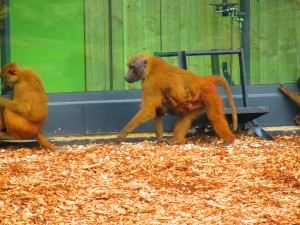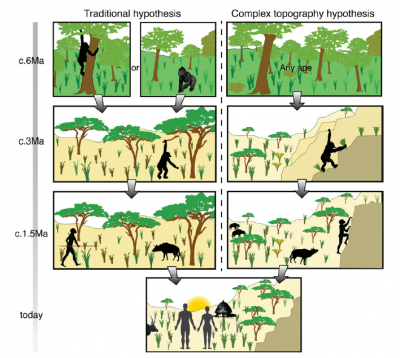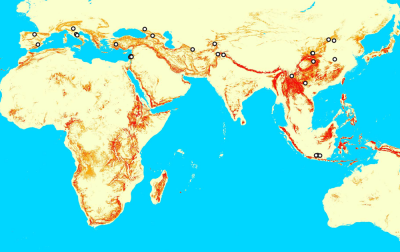Biological Approaches to Dispersal
Humans clearly behave in complex and unique ways, but we are also animals, and our ancestry is subject to many of the same evolutionary and ecological processes as other species. Biological issues are central to palaeoanthropological research, and this applies as much to the investigation of dispersal as to other aspects of human evolution. Understanding hominins as evolving organisms is therefore an important theme of DISPERSE.

A drawback of studying hominins is that we only have a relatively small amount of direct evidence. The fossil record is famously patchy, and although our ancestors are some of the best-known extinct species, there are still only a few fossil finds – and many of those are fragmentary. Specimens like ‘Ardi’ and ‘Lucy’ are the exception not the rule. Developing an understanding of our ancient ecology is therefore a challenge, requiring creative thinking to link physical remains with theories, and often relying on evidence from closely related living species like humans, nonhuman apes and monkeys (Figure 1).
The biological strand of DISPERSE focuses on a comparative approach involving other closely related primates species, with the aim of developing new understandings of hominin landscape use, palaeoecology and dispersal. One element in this is the development of the ‘complex topography hypothesis’ of human evolution (Figure 2), which suggests that living in ecologically and topographically complex landscapes was an important factor in the early human evolutionary trajectory (Winder et al. 2013). This hypothesis, in addition to highlighting the need to pay greater attention to landscape variables, suggests that complex landscapes could support a range of hominin species, occupying a suite of niches that share some features (like the use of rough ground) but not necessarily others (Winder et al. 2014).

This fits well with the empirical evidence, which suggests multiple adaptive radiations of species that are similar, but sufficiently different not to out-compete one another when living together.
The complex topography hypothesis also applies directly to dispersal. It suggests that one difference between hominins of the australopith grade and later Homo ergaster/erectus was that the former were using complex landscapes almost exclusively while the latter ranged beyond them, occupying 'edge' landcapes that combine complex topography offering ecological diversity and tactical advantage – good for hiding in and outwitting prey and predators – with flatter terrain capable of supporting larger herbivores in large numbers. We have tracked the environments used by early groups dispersing outside Africa, and in fact these seem to correspond well with the distributions of such landscapes (Winder et al., in review). Our ancestors seem to have dispersed by following the corridors where complex landscapes abut broad, animal-rich plains (Figure 3).

DISPERSE has also looked more broadly at the links between anatomy, ecology, landscapes and evolution. The complex topography hypothesis proposes that living on rough, complex terrestrial surfaces might have driven the appearance of upright bipedal locomotion among hominins by providing the framework for the locomotor transition. It also suggests that landscapes should be considered in wider efforts to explore animal evolution. Among the nonhuman primates, at the very smallest scales, there seem to be differences in the shape of particular foot bones. In Kenya, where troops of olive and yellow baboons live side-by-side, for example, the two groups seem characteristically to be found on different local landscapes, and to have anatomical differences which, though small, are statistically significant. It is hard in such cases to disentangle the effects of (partial) genetic isolation from those relating to landscape, but detailed study of the functional effects of differently shaped foot bones suggests that there may be an ecological element. Some of the differences seem to relate specifically to the stability or flexibility of joint complexes, which may be linked to movement on different substrates.

In addition to working specifically on the role of landscapes in hominin evolution, this strand of research has also focused on more theoretical aspects of our biological past. In almost every part of palaeoanthropology, simple theories of our human evolution and behaviour are gradually being supplanted by more complex ones, involving more variables, as in our addition of concepts of landscape to existing evolutionary hypotheses. It remains unclear, however, whether our evolutionary history – and indeed that of other, related species – was inherently complex, and how much we might gain from understanding that complexity in greater detail. For instance, was human evolution really a straightforward adaptive process, driven by natural selection that fitted us to live in particular – perhaps complex – habitats, or is there more to our past?
DISPERSE has begun to investigate these questions directly. It has explored, for instance, whether hominin evolution fits better with a model of evolution as a branching tree or as a web (Figure 4), and has shown that the empirical evidence from the fossil record and from studies of our close relatives suggests that far from being a neat hierarchical process, our past was reticulated (web-like) and characterised by lineages that diverge and come back together again (Winder and Winder 2014). More recently, we have started work on such questions as: 'Are our key ‘human’ traits adaptations?' 'How do cultural and biological processes interact to drive hominin evolution and dispersals?' And 'To what extent can we expect the large-scale pattern of dispersal visible in the fossil and archaeological record to be the outcome of a uniform and directional process, as opposed to a more patchy series of small-scale adjustments responding opportunistically to variable circumstances?'
References
- Winder, I.C., King, G.C.P., Devès, M. and Bailey, G.N. 2013. Complex topography and human evolution: the missing link. Antiquity 87: 333–349.
- Winder, I.C., Winder, N.P. 2014. Reticulate evolution and the human past: an anthropological perspective. Annals of Human Biology 41(4): 300–311.
- Winder, I.C., King, G.C.P., Devès, M., Bailey, G.N. 2014. Human bipedalism and the importance of terrestriality: a reply to Thorpe et al. (2014). Antiquity 88: 915–916.
- Winder, I.C., Devès, M.H., King, G.C.P., Bailey, G.N., Inglis, R.H., Meredith-Williams, M. In Review. Evolution and dispersal of the genus Homo: a landscape approach. Journal of Human Evolution.






